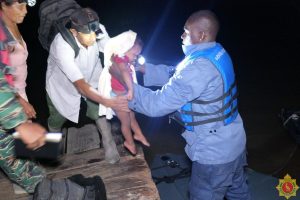Home Top Stories As wildfires rage: Emergency services fully mobilised to assist citizens – VP
As wildfires continue to rage in several communities across Guyana, several critical agencies have been mobilised to help affected citizens. Among those agencies are the Health Ministry, the Joint Services, and the Civil Defence Commission (CDC).  Raging wildfires in the Santa Mission community of Region Three (Essequibo Islands-West Demerara) on Wednesday reached a critical point, rendering it impossible for firefighters to access the affected areas to extinguish the fires. As a result, Joint Services teams shifted their focus to ensuring the safety and well-being of the residents through swift evacuation measures.
Raging wildfires in the Santa Mission community of Region Three (Essequibo Islands-West Demerara) on Wednesday reached a critical point, rendering it impossible for firefighters to access the affected areas to extinguish the fires. As a result, Joint Services teams shifted their focus to ensuring the safety and well-being of the residents through swift evacuation measures.
The dense smoke emanating from the fires has prompted the evacuation of over 25 individuals from Santa Mission and the neighbouring village of Santa Aratak. Most of the evacuees have found temporary shelter at the Timehri Primary School, while some are being accommodated by their relatives.
Battling
During his weekly press conference on Thursday, Vice President Dr. Bharrat Jagdeo disclosed that the Health Ministry is equipped and ready to provide care to individuals battling health complications brought on by the fires. These include smoke inhalation, heat stress, radiation, and air pollution.
Further, the vice president explained that the Civil Defence Commission is setting up shelters across the country and packaging food supplies for persons displaced by wildfires. And while no homes or personal assets have thus far been destroyed, farming communities that depend on agriculture are among those in need of urgent assistance.

“As the president pointed out, we are (supplying) hampers to some of the communities in Region Nine… Those places, the people mainly deal with subsistence farming; it’s not like the coast, areas where people work elsewhere. So, the issue is they just done lose income, they lose a source of food, and therefore we have supplied hampers, we’re sending in cassava from the coast to some of the hinterland communities,” the vice-president said.
The vice-president has commended the Guyana Fire Service (GFS), the Civil Defence Commission (CDC), the Environmental Protection Agency (EPA), and the Guyana Forestry Commission for working collaboratively to diligently mitigate wildfires that are threatening, and has explained that future investments garnered would strengthen Guyana’s preparedness to better manage climate-related challenges.
The vice president, who is also the pioneer of Guyana’s Low Carbon Development Strategy (LCDS), has noted that this issue of wildfires is not only affecting Guyana.
“This is something we have spoken about for a very long time: the extreme weather that we will continue to experience; that is why we are spending so much of our resources on adaptation methods,” he said, referring to the country’s investment in drainage and irrigation methods, to reduce flooding in the rainy season and retain water for the dry periods.
He noted that over US$2 billion earned from the sale of forest carbons under the LCDS will be spent on adaptation, in addition to the sums given directly to indigenous communities.
According to Chapter 5 of the LCDS 2030 document, with resources from the Guyana-Norway Partnership, Guyana developed a Climate Resilience and Adaptation Strategy to set out a comprehensive and overarching framework for adapting and building resilience to climate change impacts. The chapter summarises elements of that strategy, which include strengthening the drainage and irrigation systems, building climate resilient agricultural systems, public health adaptation to climate change, flood management, among other things.
“On the coast as well as in the hinterland, some of the areas, the crops have dried up, and the fires have affected some of the farmlands in other areas in the hinterland, so the CDC is fully mobilised…We’re supplying hampers for some of the communities in Region Nine that have had all of their crops destroyed,” the vice president has said.
El Nino
Guyana has experienced over 1300 wildfires since January, and this is a direct result of the El Nino phenomenon, which is responsible for the prolonged dry season. One thousand of those fires occurred in communities located in Regions Five (Mahaica-Berbice) and Six (East Berbice-Corentyne); whereas the regions with the lowest incidents of wildfires are Two (Pomeroon-Supenaam) and Seven (Cuyuni-Mazaruni), which both had less than 200 fires.
Joint Service teams are utilising satellite imagery surveillance to monitor fires countrywide, while land and air techniques are being used to prevent fires from escalating. Resources are stretched thin, but efforts are ongoing to procure advanced firefighting equipment specifically tailored to combat wildfires.
The Guyana Fire Service is urging citizens to avoid deliberately setting fires to either burn garbage or for land clearing, noting that such acts are punishable by law. The Fire Service, in a statement, said it is working to combat several wildfires reported at Coverden and along the Heroes Highway on the East Bank of Demerara; as well as at Port Mourant, East Berbice-Corentyne; Lovely Lass Village, West Coast Berbice; and in Linden.
Any fire or emission of excessive smoke should be reported to the Fire Service via 912.
 Raging wildfires in the Santa Mission community of Region Three (Essequibo Islands-West Demerara) on Wednesday reached a critical point, rendering it impossible for firefighters to access the affected areas to extinguish the fires. As a result, Joint Services teams shifted their focus to ensuring the safety and well-being of the residents through swift evacuation measures.
Raging wildfires in the Santa Mission community of Region Three (Essequibo Islands-West Demerara) on Wednesday reached a critical point, rendering it impossible for firefighters to access the affected areas to extinguish the fires. As a result, Joint Services teams shifted their focus to ensuring the safety and well-being of the residents through swift evacuation measures.













